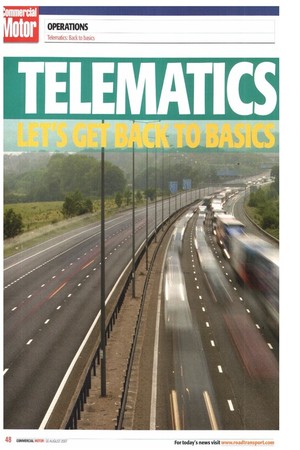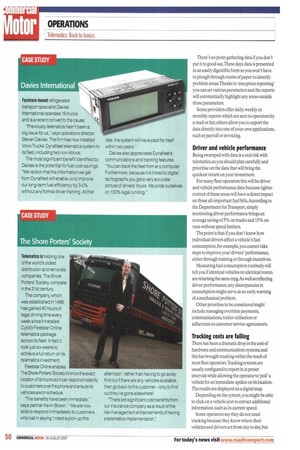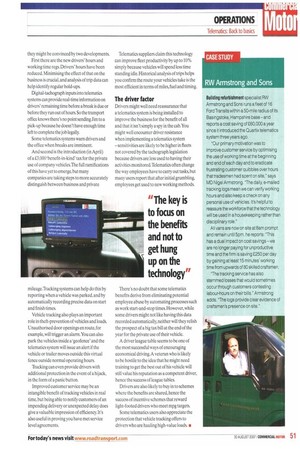TE LEMATI C S
Page 48

Page 49

Page 50

Page 51

If you've noticed an error in this article please click here to report it so we can fix it.
Are you put off telematics by jargon, hype and complexity? Our new series will make sure you don't miss out on this high-tech route to higher profits — Sharon Clancy starts at the beginning...
For many operators, telematics is associated with Big Brother-style activities such as the ill-fated and over-ambitious Lorry Road User Charging scheme or some ultra-sophisticated supply chain distribution monitoring.These images make many operators wary of introducing telematics into their fleets, despite its proven ability to enhance productivity and efficiency But to be fair, telematics has not exactly helped its own cause in the past few years.
Some operators who have dipped their toe in the water have been scalded thanks to highpressure sales tactics coupled with abysmal aftersales service and hidden airtime costs. Some salesmen simply promised more than their systems could deliver; some suppliers have been more interested in flogging the telematics black boxes than in understanding the needs of their customers.
Taking the plunge It has to be said that for most of the past 100 years operators have been running their fleets perfectly well without recourse to telematics. But as any business graduate will tell you, if you aren't measuring your performance you can't know where problems lie and which areas can be improved. By measuring performance telematics offers you that information.
The good news is that it is now easier than ever to benefit from this technology. Over the past three years there has been a shift from expensive bespoke PC-based telematics systems to internet-based tracking and reporting systems, often at a fixed cost per vehicle per week.
The key is to focus on the benefits rather than getting hung up on the technology. All you need is a basic grasp of how it all fits together so you know what is important to your operation and what questions to ask potential suppliers.
Data in, data out There are two main types of telematics data: on-board telemetry and operational data.
Vehicle telemetry can keep you up to date with fuel consumption, trip data, idling time, harsh braking, power take-off use and driver identification.
Operational data can include location, drivers' hours, event alarms, automatic arrival/ departure alerts, delivery schedules, customer addresses and navigation.
Being able to send data to the driver also improves efficiency by enabling you to react to real-time events such as route changes, new pick-ups and unexpected delays.Telematics usually does this via the text messaging service on the cellular phone networks.
In fact reducing voice communication costs with drivers is often cited as one of the major benefits of telematics — users report savings of up to 30%. There's no point gathering data if you don't put it to good use. These days data is presented in an easily digestible form so you won't have to plough through reams of paper to identify problem areas.Thanks to 'exception reporting' you can set various parameters and the reports will automatically highlight any areas outside those parameters.
Some providers offer daily, weekly or monthly reports which are sent to operators by e-mail or fax; others allow you to export the data directly into one of your own applications, such as payroll or invoicing.
Driver and vehicle performance
Being swamped with data is a real risk with telematics, so you should plan carefully and prioritise on the data that will bring the quickest return on your investment.
For many fleet operators this will be driver and vehicle performance data because tighter control of these areas will have a direct impact on those all-important fuel bills.According to the Department for Transport, simply monitoring driver performance brings an average saving of 5% on trucks and 15% on vans without speed limiters.
The point is that if you don't know how individual drivers affect a vehicle's fuel consumption, for example, you cannot take steps to improve your drivers' performance, either through training or through incentives.
Measuring fuel consumption routinely will tell you if identical vehicles on identical routes are returning the same mpg. As well as reflecting driver performance, any discrepancies in consumption might serve as an early warning of a mechanical problem.
Other priorities to be considered might include managing overtime payments, communications, trailer utilisation or adherence to customer service agreements.
Tracking costs are falling
There has been a dramatic drop in the cost of hardware and communications systems, and this has brought tracking within the reach of most fleet operators.Tracking systems are usually configured to report in at preset intervals while allowing the operator to 'poll' a vehicle for an immediate update on its location. The results are displayed on a digital map.
Depending on the system, you might be able to click on a vehicle icon to extract additional information, such as its current speed.
Some operators say they do not need tracking because they know where their vehicles and drivers are from day to day, but they might be convinced by two developments.
First there are the new drivers' hours and working time regs. Drivers' hours have been reduced. Minimising the effect of that on the business is crucial, and analysis of trip data can help identify regular hold-ups.
Digital-tachograph inputs into telematics systems can provide real-time information on drivers' remaining time before a break is due or before they run out of hours.So the transport office knows there's no point sending Jim to a pick-up because he doesn't have enough time left to complete the job legally.
Some telematics systems warn drivers and the office when breaks are imminent.
And second is the introduction (in April) of a 0,000 'benefit-in-kind' tax for the private use of company vehicles.The full ramifications of this have yet to emerge, but many companies are taking steps to more accurately distinguish between business and private mileage.Tracking systems can help do this by reporting when a vehicle was parked, and by automatically recording precise data on start and finish times.
Vehicle tracking also plays an important role in theft-prevention of vehicles and loads. Unauthorised door openings en route, for example, will trigger an alarrn,You can also park the vehicles inside a geofence' and the telematics system will issue an alert if the vehicle or trailer moves outside this virtual fence outside normal operating hours.
Tracking can even provide drivers with additional protection in the event of a hijack, in the form of a panic button.
Improved customer service may be an intangible benefit of tracking vehicles in real time, but being able to notify customers of an impending delivery or unexpected delay does give a valuable impression of efficiency It's also useful in proving you have met service level agreements, Telematics suppliers claim this technology can improve fleet productivity by up to 10% simply because vehicles will spend less time standing idle. Historical analysis of trips helps you confirm the route your vehicles take is the most efficient in terms of miles, fuel and timing.
The driver factor
Drivers might well need reassurance that a telematics system is being installed to improve the business for the benefit of all and that it isn't simply a spy in the cab.You might well encounter driver resistance when implementing a telematics system —sensitivities are likely to be higher in fleets not covered by the tachograph legislation because drivers are less used to having their activities monitored.Telematics often change the way employees have to carry out tasks, but many users report that after initial grumbling, employees get used to new working methods, There's no doubt that some telematics benefits derive from eliminating potential employee abuse by automating processes such as work start-and-stop times. However, while some drivers might not like having this data recorded automatically, neither will they relish the prospect of a big tax bill at the end of the year for the private use of their vehicle.
A driver league table seems to be one of the most successful ways of encouraging economical driving. A veteran who is likely to be hostile to the idea that he might need training to get the best out of his vehicle will still value his reputation as a competent driver, hence the success of league tables.
Drivers are also likely to buy in to schemes where the benefits are shared, hence the success of incentive schemes that reward light-footed drivers who meet mpg targets.
Some telematics users also appreciate the protection that vehicle tracking offers to drivers who are hauling high-value loads. is






















































































































































































